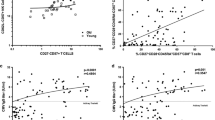Abstract
Dendritic cells (DCs) are the most powerful antigen presenting cells (APCs) in the immune system. Therefore, they are able to take up antigen by phagocytosis, macropinocytosis or endocytosis, process it in the cytosol and present it to naive T cells. It is known that presentation of the immunodominant influenza virus nucleoprotein-derived CTL epitope is delayed in bone marrow-derived DCs (BMDCs) compared to non-professional APCs. This delay coincided with the formation of transient aggregations of ubiquitinated proteins (DALIS, dendritic cell aggresome-like induced structures), which contain probably defective ribosomal products (DRiPs). DRiPs appear in the cytosol of maturing DCs and macrophages. Normally, DRiPs are degraded rapidly by proteasomes. However, their storage in DALIS delays their degradation. So, it is hypothesized that DALIS can function as antigen depots allowing DCs to coordinate maturation and antigen presentation during their migration to the lymph nodes. Upon inhibition of several pathways among the in signal transduction pathways of DCs, like the phosphatidylinositol 3-kinase (PI3-K) or the mammalian target of Rapamycin (mTOR), the cells show a rendered maturation profile. The formation of DALIS is inhibited in these cells which can be expected to influence antigen processing and presentation.



Similar content being viewed by others
Abbreviations
- BMDC:
-
Bone marrow-derived dendritic cell
- CTL:
-
Cytotoxic T lymphocytes
- DALIS:
-
Dendritic cell aggresome-like induced structures
- DRiPs:
-
Defective ribosomal products
- mCMV:
-
Murine cytomegalovirus
- NP:
-
Nucleoprotein
- PI3-K:
-
Phosphatidylinositol 3-kinase
- mTOR:
-
Mammalian target of Rapamycin
- TLR:
-
Toll-like receptor
- LPS:
-
Lipopolysaccharid
References
Mellman I, Steinman RM (2001) Dendritic cells: specialized and regulated antigen processing machines. Cell 106:255–258
Guermonprez P, Valladeau J, Zitvogel L, Thery C, Amigorena S (2002) Antigen presentation and T cell stimulation by dendritic cells. Annu Rev Immunol 20:621–667
Lelouard H, Gatti E, Cappello F, Gresser O, Camosseto V, Pierre P (2002) Transient aggregation of ubiquitinated proteins during dendritic cell maturation. Nature 417:177–182
Canadien V, Tan T, Zilber R, Szeto J, Perrin AJ, Brumell JH (2005) Cutting edge: microbial products elicit formation of dendritic cell aggresome-like induced structures in macrophages. J Immunol 174:2471–2475
Herter S, Osterloh P, Hilf N, Rechtsteiner G, Hohfeld J, Rammensee HG, Schild H (2005) Dendritic cell aggresome-like-induced structure formation and delayed antigen presentation coincide in influenza virus-infected dendritic cells. J Immunol 175:891–898
Cantley LC (2002) The phosphoinositide 3-kinase pathway. Science 296:1655
Reuben JS (2006) Ras, PI(3)K and mTOR signalling controls tumor cell growth. Nature 441:424–430
Yewdell JW, Schubert U, Bennink JR (2001) At the crossroads of cell biology and immunology: DRiPs and other sources of peptide ligands for MHC class I molecules. J Cell Sci 114:845–851
Yewdell J (2002) To DRiP or not to DRiP: generating peptide ligands for MHC class I molecules from biosynthesized proteins. Mol Immunol 39:139–146
Yewdell JW, Anton LC, Bennink JR (1996) Defective ribosomal products (DRiPs): a major source of antigenic peptides for MHC class I molecules? J Immunol 157:1823–1826
Schubert U, Anton LC, Gibbs J, Norbury CC, Yewdell JW, Bennink JR (2000) Rapid degradation of a large fraction of newly synthesized proteins by proteasomes. Nature 404:770–774
Lelouard H, Ferrand V, Marguet D, Bania J, Camosseto V, David A, Gatti E, Pierre P (2004) Dendritic cell aggresome-like induced structures are dedicated areas for ubiquitination and storage of newly synthesized defective proteins. J Cell Biol 164:667–675
Bhattacharyya S, Sen P, Wallet M, Long B, Baldwin AS Jr., Tisch R (2004) Immunoregulation of dendritic cells by IL-10 is mediated through suppression of the PI3K/Akt pathway and of IkappaB kinase activity. Blood 104:1100–1109
Del Prete A, Vermi W, Dander E, Otero K, Barberis L, Luini W, Bernasconi S, Sironi M, Santoro A, Garlanda C, Facchetti F, Wymann MP, Vecchi A, Hirsch E, Mantovani A, Sozzani S (2004) Defective dendritic cell migration and activation of adaptive immunity in PI3Kgamma-deficient mice. EMBO J 23:3505–3515
Ardeshna KM, Pizzey AR, Devereux S, Khwaja A (2000) The PI3 kinase, p38 SAP kinase, and NF-kappaB signal transduction pathways are involved in the survival and maturation of Lipopolysaccharide-stimulated human monocyte-derived dendritic cells. Blood 96:1039–1046
Hackstein H (2002) Rapamycin inhibits macropinocytosis and mannose receptor-mediated endocytosis by BMDC. Blood 100(3):1084
Morice WG (1993) Rapamycin inhibition of interleukin-2-dependent p33cdk2 and p34cdc2 kinase activation in T lymphocytes. J Biol Chem 268(30):22737–22745
Sehgal SN (1998) Rapamune® (RAPA, rapamycin, sirolimus): mechanism of action immunosuppressive effect results from blockade of signal transduction and inhibition of cell cycle progression. Clin Biochem 31(5):335–340
Lelouard H (2007) Regulation of translation is required for dendritic cell function and survival during activation. JCB 179(7):1427–1439
Reddehase MJ (2002) Antigens and immunoevasins: opponents in cytomegalovirus immune surveillance. Nat Rev Immunol 2:831–844
Wagner M, Gutermann A, Podlech J, Reddehase MJ, Koszinowski UH (2002) Major histocompatibility complex class I allele-specific cooperative and competitive interactions between immune evasion proteins of cytomegalovirus. J Exp Med 196:805–816
Author information
Authors and Affiliations
Corresponding author
Additional information
This work was supported by grants from the Deutsche Forschungsgemeinschaft (Sonderforschungsbereich 490, individual projects E6 to H.S. and E3 to R.H.).
Rights and permissions
About this article
Cite this article
Faßbender, M., Herter, S., Holtappels, R. et al. Correlation of dendritic cell maturation and the formation of aggregates of poly-ubiquitinated proteins in the cytosol. Med Microbiol Immunol 197, 185–189 (2008). https://doi.org/10.1007/s00430-008-0091-4
Received:
Published:
Issue Date:
DOI: https://doi.org/10.1007/s00430-008-0091-4




